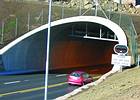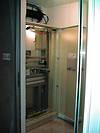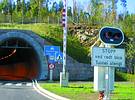

Norway has the highest concentration of road tunnels per inhabitant in the world. Naturally, the safety of commuters using the tunnels is a key factor in their design. Furthermore, the control and monitoring system must be secure, very reliable and ideally handle high data volumes that are required with video surveillance systems.
The 'Riksvei 4-Nitedal' tunnel is equipped with a redundant ring of Industrial Ethernet Switches. The Ethernet ring has a total length of over 5 km and is used as the communications highway to control the ventilation, illumination, traffic control signs and emergency telephones within the tunnel. The control centre is based at the road traffic central unit in Oslo. The tunnel system comprises of 11 remote I/O cabinets, four programmable logic stations and 15 video cameras.
The communications backbone is a 100-megabit Ethernet network connected to form a redundant ring. Single-mode fibre is installed to ensure that the network capacity is sufficient to handle the large amount of data transmitted and also to future proof the installation as technology steps forward.
Technology
Ethernet has been used in office-based applications for over two decades. In fact, the main protocols have not changed since Robert Metcalfe and David Boggs (Metcalfe's assistant) published a paper entitled, "Ethernet: distributed packet-switching for local computer networks." in 1976.
Ethernet has many advantages over traditional field buses - the primary advantage being the vastly enhanced data throughput. This enables extensive use of video cameras in conjunction with the more common control equipment all connected on to the same backbone ring through Industrial Ethernet 'ring switches'.
Data throughput can be further enhanced by implementing QoS (quality of service). This can improve data rates by prioritising data into different queues; up to eight different levels of priority are available rather than the more common low and high priority. These enhanced switching methods work in unison with standard features such as learning; where the switch learns the destination and source address from each data packet.
Ethernet ring
The switches are connected into a ring using single mode fibre cables. The main feature of the ring is the ability of the system to detect a fibre or link failure and re-route data in the opposite direction. This process takes 30 ms, a virtually seamless process that ensures important signals will not be lost. In this tunnel application 18 OnTime Ring Switches are formed into a ring that automatically takes care of this critical network service.

Network monitoring
Principally, the ability of the network to monitor, detect and recover from such a network failure within 30 ms is a major benefit to any communications infrastructure. However, it is also important that if such a failure does occur, operators and engineers are made aware so they can start remedial action.
This is achievable with two methods:
* Fault contact.
A user configurable fault contact highlights failures via a solid-state relay.
* Simple network management protocol (SNMP).
Using SNMP enables pro-active and re-active fault analysis of a network. This data can be managed to link to a scada system thus enabling graphical representation of a network that operators can understand regardless of Ethernet knowledge or training.

New demands
The use of video surveillance systems is increasing in traffic control. Newer and cost-effective cameras can now send high quality pictures using Ethernet as the medium. However, these demand greater bandwidth and therefore increase network activity.
Increased bandwidth should not necessarily cause concern if the network configuration is correctly engineered. As discussed, packet prioritisation can assist network throughput. In addition, Multicast techniques can also diminish overall network load.
Video transmission over Ethernet is enhanced when Multicast techniques are employed. Multicast is when data is sent out to multiple devices on a network by a host. This can be referred to as one-to-many or many-to-many. Network bandwidth can be kept to a minimum as data can be routed to unique devices rather than all devices (broadcast). To further enhance such networks the Internet Group Management Protocol (IGMP) can be used.
The OnTime switches can act as IGMP servers. In principle, when a video camera has traffic for a destination, 'join' information is sent to switches containing relevant addresses. The switches then direct traffic to the required ports using multicast filtering, so total traffic is kept to a minimum. Finally, when a camera or device has finished sending video, a 'leave' message is sent to the required switches so data is not sent to 'redundant' devices.
Industrial environment
Although the type of data that is sent over office-based Ethernet in relation to industrial-based Ethernet is identical there are considerable differences in hardware design.
As highlighted above, the ability to monitor, detect and recover from a system failure within 30 ms is mandatory in industrial, safety critical applications. To further enhance system reliability high MTBF (mean time between failure) figures and wide operating temperature ranges (-40 -> +70°C) are also obligatory. Furthermore, the power consumption should be low to reduce UPS (uninterruptible power supply) load thus ensuring that a critical communications network will still be functional after a power outage.
For more information contact Bob Petrie, Throughput Technologies, 011 705 2497, [email protected], www.throughput.co.za
| Tel: | +27 11 705 2497 |
| Email: | [email protected] |
| www: | www.throughput.co.za |
| Articles: | More information and articles about Throughput Technologies |

© Technews Publishing (Pty) Ltd | All Rights Reserved